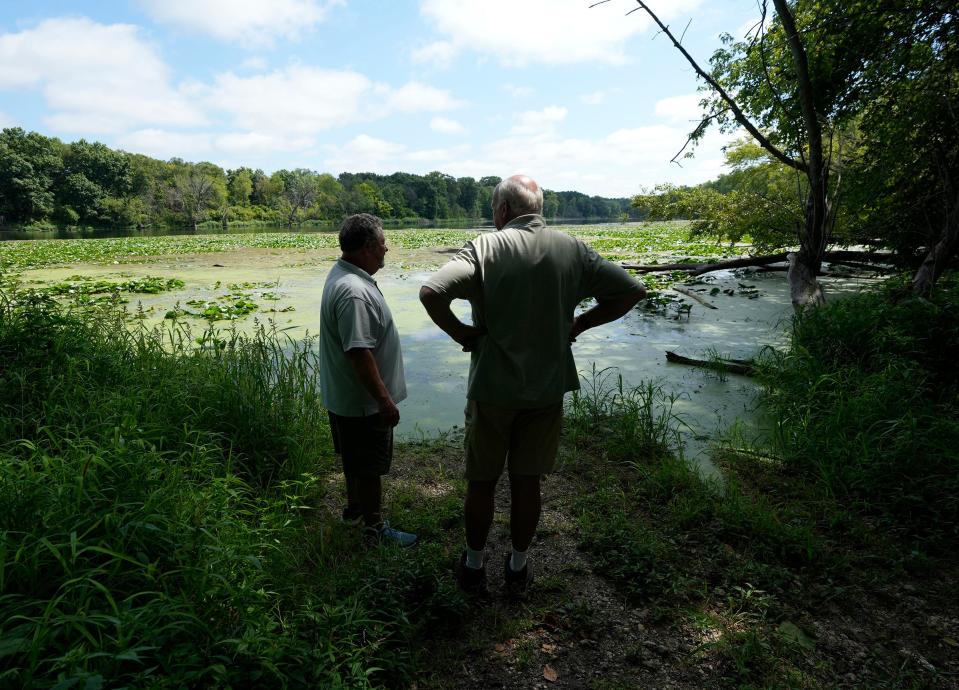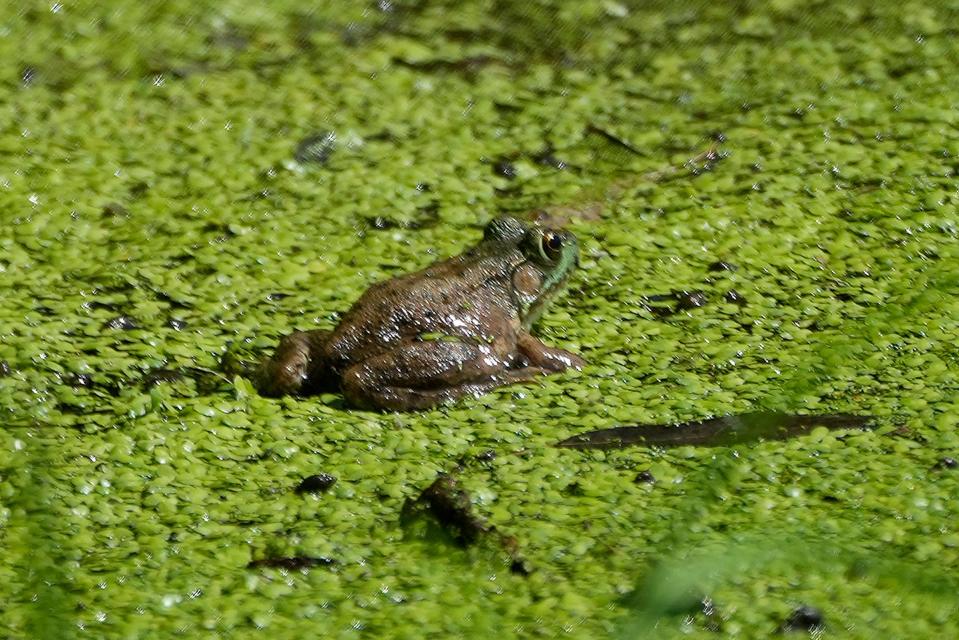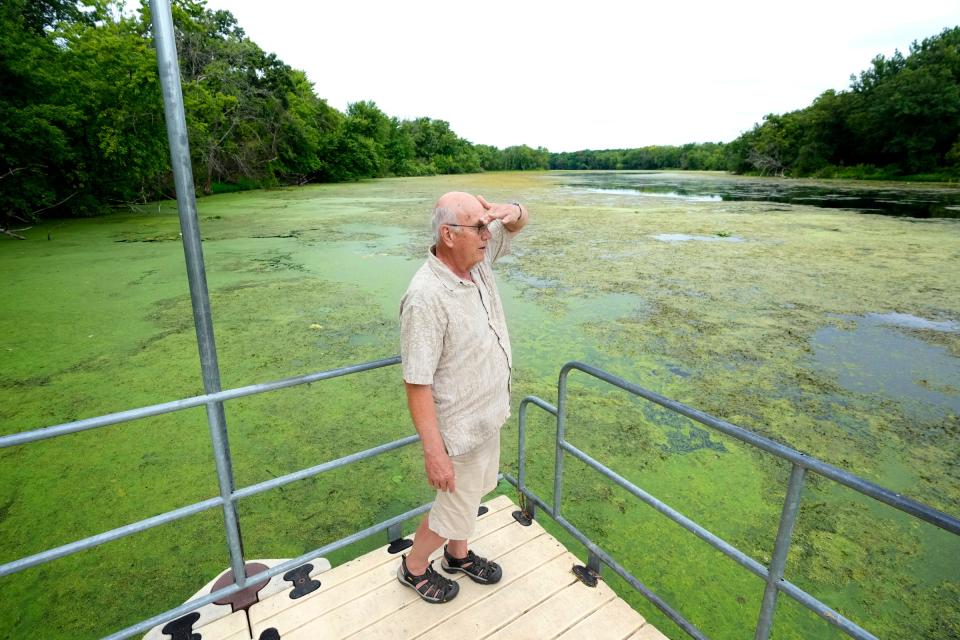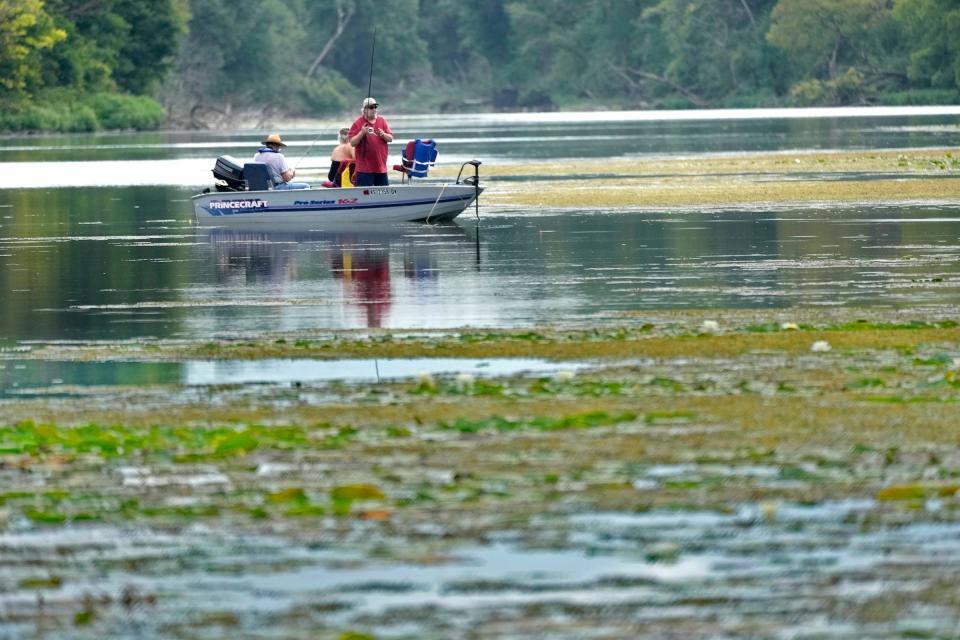50 years ago, the Trempealeau Lakes were pristine. Now, algae carpets their surface. Can they be saved?
TREMPEALEAU - When Barry Drazkowski moved his family cabin to the shores of Third Lake in Trempealeau in 1971, the water was crystal-clear.
Fish abounded and so did anglers intent on catching them. He recalled sitting on his front lawn and watching a steady stream of boats motor past.
Today, the water is barely visible under thick mats of bright green algae. A few fishers still try their luck, but it's hard for a hook to pierce through. Nearby Second Lake, which has the same problem, looks more like a lawn than a body of water. Locals joke that you could walk your dog across it.
"It's not like it used to be," Drazkowski said. "It's changed a lot for us."
These two lakes, plus another — First Lake — are part of what's known as the Trempealeau Lakes, located just south of the village of Trempealeau, in far-western Wisconsin. They've long been a prized natural resource in the region, beloved for fishing and recreation. Though many so-called lakes along the Mississippi River are languid backwaters that connect to the river, these three are their own entity. They're spring-fed from groundwater that filters down from higher altitudes.

Right now, that's a big source of their problems.
Those higher grounds are dominated by farmland, and excess nitrogen from fertilizer and irrigation systems is leaking through the soil and ending up in the lakes, producing the perfect conditions for algae to bloom. Data from the Wisconsin Department of Natural Resources shows that nitrogen levels in Second Lake, for example, have tripled since the 1970s.
Drazkowski and other residents with a vested interest in improving the lakes are stepping up to try to help them. They formed a nonprofit, Friends of Trempealeau Lakes, to convince area farmers to reduce nitrogen use. Bud Hammes, who has a summer cottage near the lakes, and chairs the group, said participants hope to bolster government efforts, which often lack funding, and demonstrate that the community cares about issues like these.
"There's a vacuum in how these kinds of environmental issues can be addressed," Hammes said. "Without grassroots community organizing groups to say we have a problem here, and bringing people together and finding resources, these problems don't get solved."

Sandy soils allow more nitrogen to slip down into lakes
The farm fields just above the lakes, a 30-square-mile area known as the Trempealeau Terrace, are owned by about a dozen people and used for cash crops, especially corn. That land has always been agricultural, Drazkowski said. But in the 1990s, producers turned to so-called "pivot irrigation" to maximize crop yields, which groundwater experts say can, in some cases, result in increased nitrogen leaching.
The type of soil in the region doesn't help. It's sandy, which allows water and other nutrients to drain through more easily than in other soil types. Trempealeau lies in one of the more susceptible areas in the state to groundwater nitrogen pollution, said Shawn Giblin, a water quality specialist for the DNR who works in the Mississippi River region.
That area isn't alone.
Nitrate is the most widespread contaminant of Wisconsin's groundwater, and a 2022 report from the Wisconsin Groundwater Coordinating Council said the contamination is "increasing in extent and severity." Dozens of municipal water supply systems have had nitrate levels that exceed safe limits, according to the report, and about 10% of private wells exceed that standard too. In intensely agricultural areas, double or triple that many well samples exceed it, the report says. While some nitrate pollution in groundwater can come from septic systems and lawn fertilizers, an estimated 90% comes from agricultural sources.
Repeated complaints about the condition of the three lakes gave rise to a study of their conditions. Giblin collected samples from six spots across each of the lakes during the summer of 2021 to measure nitrogen and phosphorus, along with several other parameters. He presented those results to area residents in early 2022, but as both he and Hammes agreed, they didn't need data to know something was wrong.
More: How local Wisconsin groups monitor toxic algae in the absence of state testing
Trying to navigate the lakes to collect samples, Giblin recounted, was like trying to canoe over wet carpet. At the beginning of the study, he even witnessed something that he'd only seen once before in his career: a whiting event, which happens when the pH of a water body is so high that calcium carbonate is produced, turning the water milky white. An overabundance of algae production can raise the pH, he said.
"It just shows you how out of sync things are down there," Giblin said.
Luckily, the algae in the Trempealeau Lakes is not blue-green algae, which can be toxic to people and pets — though that's a problem in the nearby Trempealeau National Wildlife Refuge. But it can have other effects on the environment, like depleting oxygen to the point that fish can't survive. And the sick-looking water drives people away from recreating there, a blow for the region's strong outdoor tourism economy.
Group aims for a non-judgmental approach to working with farmers
Friends of Trempealeau Lakes leaders, including Hammes and vice chair Todd Ondell, are taking a cautious approach to reaching out to farmers to discuss reducing nitrogen. Their aim is to find a way that farmers can cut back on nitrogen use while still producing successful crop yields — starting with those who are already interested in such strategies, then expanding as they build trust.
Finger-pointing, Hammes argued, not only doesn't work, but isn't fair.
"We're not coming into this with any judgmental attitude," he said. "We have this problem and we know that (agriculture is) one of the sources of the problem, not because anyone has purposely been doing it."
More: In this western Wisconsin river, scientists see hope for saving endangered mussel species
In late August, they met with their first producer, who farms about 3,000 acres of corn, soybeans, alfalfa and other crops. The farmer spoke about what he's already doing to reduce nitrogen leaching, like cover cropping and applying fertilizer more precisely. He also touched on challenges farmers face: money to buy costly equipment, complex rules for government conservation programs and weather unpredictability, among others.

The Friends will try to figure out how to address those problems, helping farmers find resources that can both help them stay profitable and lessen their environmental impact. Reducing nitrogen alone could have a big impact, Giblin explained, because curtailing one nutrient that leads to algae growth will slow its overall growth entirely.
If the effort works, it could serve as a template for other environmental and agricultural partnerships across the state. Hammes hopes that because the number of farmers involved is relatively small, they'll be able to find common ground and work together.
"This isn't something we're going to have solved by next year. This is a change of practice that will take some years to really see results," Hammes said. "But if we don't get started, we'll never be successful."
In the meantime, the group has other plans, too. They want to raise enough money to conduct a small dredging project in Second Lake, deepening the lake bottom about nine feet near a fishing float to provide better habitat for fish. That would also slow the proliferation of curlyleaf pondweed, an invasive species that needs access to sunlight to feed its explosive growth.
Their work will dovetail with an upcoming project by Trempealeau County's Department of Land Management, which received a roughly $11,000 grant from the DNR to develop a management plan for First and Second lakes. The department will be able to assess the lakes' historical water quality and identify problems and threats to the ecosystem, said director Mike Kornmann.

Kornmann said having a nonprofit group advocating for the health of the lakes could be a boon, particularly if they're able to engage everyone that uses, impacts and cares about them.
Giblin is also optimistic that their approach can work.
"It's uplifting to see people band together to protect something ... they recognize their community's really tied to these regionally important lakes, and they're doing something about it," he said. "I think they're going to be really successful."
Madeline Heim is a Report for America corps reporter who writes about environmental issues in the Mississippi River watershed and across Wisconsin. Contact her at 920-996-7266 or mheim@gannett.com.
Please consider supporting journalism that informs our democracy with a tax-deductible gift to this reporting effort at jsonline.com/RFA or by check made out to The GroundTruth Project with subject line Report for America Milwaukee Journal Sentinel Campaign. Address: The GroundTruth Project, Lockbox Services, 9450 SW Gemini Dr, PMB 46837, Beaverton, Oregon 97008-7105.
This article originally appeared on Milwaukee Journal Sentinel: Group aims to curb algae issues on once-pristine Wisconsin lakes

